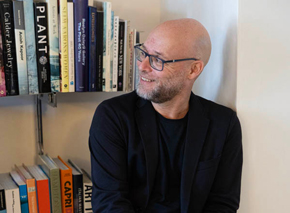Our cup Runnicled over
A music review by Fraser Beath McEwing
With Mahler’s Fourth Symphony such a dominant work in last night’s Emirates SSO concert, the rest of the music could have been seen as padding. But this wasn’t the case by a long way.

Sir Donald Runnicles
Since I was not familiar with the opening piece by Viennese-born Anton Webern (1883 -1945), I expected a dose of atonality because Webern was part of the early 1900s experimental period fertilised by Arnold Schoenberg using what became the 12-tone technique, which can sometimes sound like instrumental sound effects. But Webern’s 15-minute tone poem Im Sommerwind turned out to be a sheer delight of conventional harmony with some sublime passages exploiting bass writing. The final chord of utter tranquillity was a standout for me – and no doubt for conductor Sir Donald Runnicles, whose sensitivity to the emotional demands of all the works in the program was up to his usual high standard.
While the inclusion of a soprano solo in the fourth movement Mahler’s Fourth Symphony is often discussed, the concert took on an extra vocal dimension when Chinese soprano Ying Fang sang six Richard Strauss songs prior to intermission. Principally an opera singer, she is no stranger to stage solo performances such as the Strauss songs and the Mahler Fourth.
Fang, at age 37, already occupies an enviable position in the international soprano pecking order, with continuing critics’ rave notices for her voice and impeccable delivery. Born in China, she studied at the Shanghai Conservatoire and was accepted as a student at New York’s Julliard School – an achievement in itself. She went on to become one of the youngest opera singers to win the China Golden Bell Award for Music.
Although the puce petals were doing their acoustic best suspended as they are from the ceiling of the concert hall, the balance between solo singers and orchestra is always a challenge. This is where Sir Donald’s judgement shone, as he managed to stuff a sock into the orchestra without destroying the music. However, I’ve asked this question before and I ask it again: why not microphone the soloist? Okay, so the composer didn’t write the score to include a microphone but neither did he write for the demands of massive concert halls and glass-breaking orchestras.

Ying Fang
Notwithstanding my volume grizzles, Fang’s Richard Strauss was enchanting. Admittedly, even though my front-row seat gave me a privileged assessment of Fang’s voice and interpretation, I believe she would have easily reached those in the body of the concert hall, both in her tender, almost after-thought passages up to when she radiantly lifted the roof. The same applied to her solo in the Mahler final movement. Again, Runnicle’s sense of balance and his ability to coach impeccable detail from the orchestra stood out.
Mahler’s Symphony No. 4 in G major was composed between 1899 and 1900, and premiered in 1902. It was originally supposed to have six movements, but by the time it was released Gustav had cut it to four.
While some Mahler symphonies call for massive orchestral forces, the Fourth is comparatively lightly scored and relatively short. The trombone and tuba players, along with other blast-enabled brass, and a few strings, were given an early mark – maybe because this work evokes the gentle side of Mahler’s own remembered childhood. Some critics have explained the lightweight forces as Mahler’s intent to be more accessible to sometimes-perplexed audiences. But it didn’t work out like that for the Fourth, taking many years to attain the popularity it enjoys today. This especially applies to the fourth and final movement where the solo soprano, using the words of a German poem published a hundred year earlier, imagines a child’s vision of heaven.
The symphony follows a four-movement structure, adopting sonata form:
I. Bedächtig, nicht eilen(deliberate, unhurried)
II. In gemächlicher Bewegung, ohne Hast(in measured tempo, unhurried)
III. Ruhevoll,poco adagio (calm, somewhat slowly)
IV. Sehr behaglich(at ease)
As we’ve come to expect from Mahler, there are frequent detours into light, almost frivilous passages before returning to the main narratives. If he liked a particular tune it was likely to reapapear in more than one movement. The Fourth spends much of its time in subdued mode, where a pizzicato base often underpins restrained walzes, broken only occasionally by a climactic explosion.
Although it has often been said that the slow movement of Mahler’s Fifth Symphony contains some of the most beautiful music ever written, the slow movement from the Fourth isn’t far behind, given its extra length and dramatic interventions here and there.
Last night’s concert was much more attractive than I had anticipated. Although it was probably intended to highlight Mahler and to a lesser degree, Richard Strauss, Webern won my cigar.
SSO Sydney Opera House concert 25 September 2024







